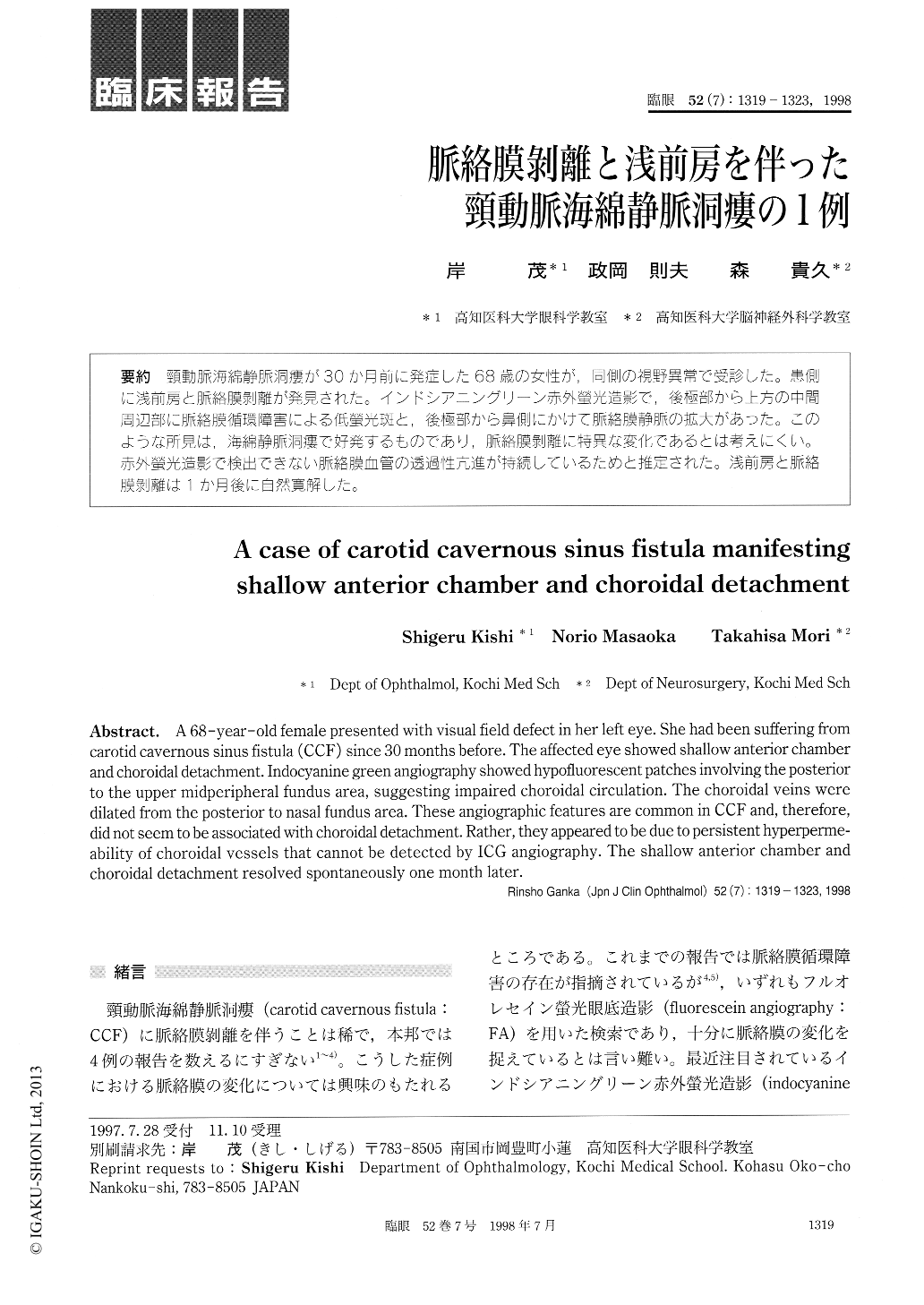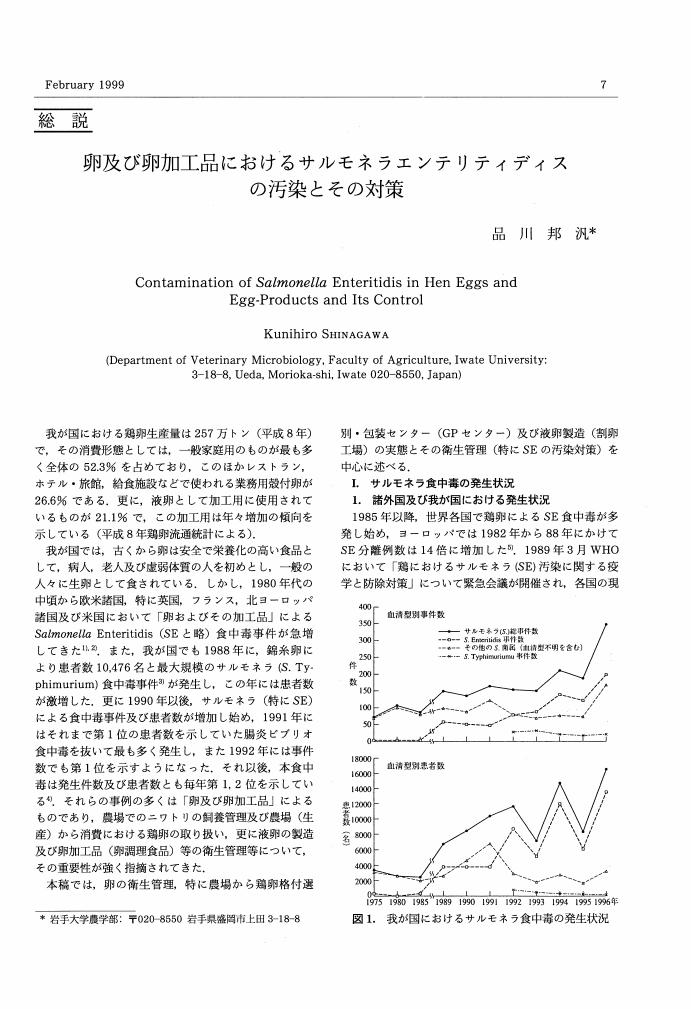- 著者
- 渋谷 武弘
- 出版者
- 神戸史学会
- 雑誌
- 歴史と神戸 : 神戸を中心とした兵庫県郷土研究誌 (ISSN:02887789)
- 巻号頁・発行日
- vol.59, no.3, pp.3-11, 2020-06
2 0 0 0 OA アニメに見るスポーツ・ジェンダー・部活動 ―『けいおん!』と『Free!』の比較考察 ―
- 著者
- 霜村 光寿
- 出版者
- 実践女子大学
- 雑誌
- 実践女子大学短期大学部紀要 = Jissen Women’s Junior College Review (ISSN:24344583)
- 巻号頁・発行日
- vol.41, pp.75-88, 2020-03-09
戦後日本において,スポーツの普及は学校教育での運動部活動に負うところが大きいが,近年では部活動が抱える問題が顕在化し,そこには現代社会が抱えるスポーツ,ジェンダーの問題の縮図的構造も垣間見える。本稿は,テレビ放映されたアニメーション作品を題材に,スポーツ,ジェンダー,部活動に対して持たれているイメージを比較分析,析出することで,現代社会における課題解決のための手がかりを提供するものである。
2 0 0 0 OA 魚類の栄養、 特にビタミンに関連する諸問題 (2)
- 著者
- 橋本 芳郎
- 出版者
- Japanese Society for Aquaculture Science
- 雑誌
- 水産増殖 (ISSN:03714217)
- 巻号頁・発行日
- vol.3, no.3, pp.12-27, 1956-03-20 (Released:2010-06-30)
- 参考文献数
- 70
2 0 0 0 これで安心!セキュリティ相談室 今月のテーマ メール利用の注意点
- 著者
- SECURITYFRIDAY
- 出版者
- 日経BP社
- 雑誌
- 日経バイト (ISSN:02896508)
- 巻号頁・発行日
- no.238, pp.142-145, 2003-03
先日,友人とささいな出来事で口論になりました。それ以来,その友人から大量の添付ファイルが付いた「嫌がらせメール」が毎日数十通も送られてくるようになりました。抗議しても「知らない」「やっていない」と言われます。どうしたらよいのでしょうか。警察に相談すべきですか。 このような「嫌がらせメール」に関するトラブルが最近,私のところにもよく来るようになりました。
2 0 0 0 OA 日本スポーツマネジメント学会 第10回大会講演録: シンポジウムⅠ
- 出版者
- 日本スポーツマネジメント学会
- 雑誌
- スポーツマネジメント研究 (ISSN:18840094)
- 巻号頁・発行日
- vol.12, no.2, pp.77-99, 2020-12-25 (Released:2021-03-10)
2 0 0 0 IR 現代英語の迂言的doを遡る
- 著者
- 宮前 和代
- 出版者
- 専修大学外国語教育研究室
- 雑誌
- 専修大学外国語教育論集 (ISSN:13403303)
- 巻号頁・発行日
- no.48, pp.27-49, 2020-02-28
2 0 0 0 OA スギ・ヒノキ林における水平根が発揮する抵抗力の検討
- 著者
- 木下 篤彦 坂井 佑介 大野 亮一 田畑 三郎 川島 正照 山崎 孝成
- 出版者
- 公益社団法人 砂防学会
- 雑誌
- 砂防学会誌 (ISSN:02868385)
- 巻号頁・発行日
- vol.65, no.5, pp.11-20, 2013-01-15 (Released:2015-08-03)
- 参考文献数
- 11
- 被引用文献数
- 8
Tree roots with an underground lateral network play a very important role in slope stability. In studies such as those by Tsukamoto(1987)and Abe(1997), the authors focused on roots that have a vertical connection between the surface soil layer and below, but they did not place much emphasis on the lateral spread of roots. Because slope failures occur in three dimensions, horizontal roots fully demonstrate their resistance against the failure. This paper aims to describe the resistance force Δ C that lateral roots provide. Two types of field investigations were made. One was the root pulling test to monitor the strength of a root pulled by a clamp. The other surveyed the lateral root distribution exposed in vertical sections excavated in the plots of Japanese cypress and cedar forests. The observed root distribution was used to calculate the resistance force Δ C. The field data show that as the distance between two trees increases, the Δ C value gets smaller. Their relationship can be described by a negative power function. It has also been proven that as the age of a tree increases so does the Δ C, but its increment gets smaller in the later stages of the tree's lifecycle. Intensive work with the field data has shown that forest thinning operations might decrease the root volume after felling and bring about an increase of Δ C that lasts for several decades. Moreover, thinning operations produce good results in slope stability when lateral roots are effectively increased. However, if the increase is insufficient, it might not contribute to slope stability.
2 0 0 0 OA 海産枝角類の生活史
- 著者
- 遠部 卓
- 出版者
- 日本プランクトン学会
- 巻号頁・発行日
- vol.25, no.1, pp.41-54, 1978 (Released:2011-03-05)
2 0 0 0 脈絡膜剥離と浅前房を伴った頸動脈海綿静脈洞瘻の1例
頸動脈海綿静脈洞瘻が30か月前に発症した68歳の女性が,同側の視野異常で受診した。患側に浅前房と脈絡膜剥離が発見された。インドシアニングリーン赤外螢光造影で,後極部から上方の中間周辺部に脈絡膜循環障害による低螢光斑と,後極部から鼻側にかけて脈絡膜静脈の拡大があった。このような所見は,海綿静脈洞瘻で好発するものであり,脈絡膜剥離に特異な変化であるとは考えにくい。赤外螢光造影で検出できない脈絡膜血管の透過性亢進が持続しているためと推定された。浅前房と脈絡膜剥離は1か月後に自然寛解した。
2 0 0 0 OA 岩手県下における,ある精薄一家の生存実態と特殊教育就学指導に関する臨床報告
- 著者
- 山本 実
- 出版者
- 岩手大学教育学部
- 雑誌
- 岩手大学教育学部研究年報 = Annual report of the Faculty of Education, University of Iwate (ISSN:03677370)
- 巻号頁・発行日
- vol.29, pp.97-126, 1969-12-28
2 0 0 0 OA 妊娠・産後の骨盤痛が歩行に及ぼす影響:システマティックレビュー システマティックレビュー
- 著者
- 坂本 飛鳥 星 賢治 岸川 由紀 田中 真一 蒲田 和芳
- 出版者
- 日本ヘルスプロモーション理学療法学会
- 雑誌
- ヘルスプロモーション理学療法研究 (ISSN:21863741)
- 巻号頁・発行日
- vol.10, no.1, pp.1-8, 2020-04-30 (Released:2020-05-22)
- 参考文献数
- 29
- 被引用文献数
- 1
[目的]妊娠・出産に関連する骨盤痛が妊娠中・産後女性の歩行に及ぼす影響を,文献レビューにより明らかにすることを目的とした。[方法]6つの文献データベースとハンドサーチにて検索した論文について,採択基準(妊娠期または産後の骨盤痛を有する女性の歩容の特徴)をもとに,該当論文を1)歩行速度,2)歩隔・歩幅・歩行周期,3)骨盤-胸郭,体幹,股関節,COP の3つの項目について整理した。文献の評価にはRisk of Bias Assessment Tool for Nonrandomized Studies (RoBANS)を使用した。[結果]採択論文は6編であった。6編より,妊娠中に骨盤痛があると歩行速度は低下し,歩幅は短く,両脚支持期の延長を認めたが,歩隔には有意差を認めなかった。胸郭・骨盤回旋の動きは増大し,骨盤の前後傾と股関節伸展可動域は減少した。[結論]妊娠中に骨盤痛があると顕著な歩容の変化が生じる。一方,産後における骨盤痛の歩容への影響は不明である。
2 0 0 0 OA 開かれた婚姻制度のための公共的理性
- 著者
- 金野 美奈子
- 出版者
- 東京女子大学現代教養学部国際社会学科社会学専攻紀要編集委員会
- 雑誌
- 東京女子大学社会学年報 (ISSN:21876401)
- 巻号頁・発行日
- vol.3, pp.17-32, 2015-03-02
婚姻は,多くの人々にとって生活の中心の一つであり価値ある人間関係を築く場であるだけでなく,物質的な生活からアイデンティティのあり方までその人のさまざまな側面を規定しうる存在である.人々がどのように自らの婚姻を経験するかは,当該政治社会が婚姻という領域をどのように位置づけ,規定し,その関係を支え,また規制するか,つまり「婚姻制度」に大きく影響を受ける.政治社会が婚姻をどのように制度化すべきかをめぐっては,それぞれの時代に応じて,議論と変革が繰り返し行われてきた.近年においてもまた,日本の文脈では夫婦別姓,またより広い文脈においては同性婚や複婚(ポリガミー)など,オルタナティヴな婚姻制度をめぐる議論が活発になっており,また制度的変革も一定程度進展してきている.
2 0 0 0 OA 卵及び卵加工品におけるサルモネラエンテリティディスの汚染とその対策
- 著者
- 品川 邦汎
- 出版者
- Japanese Society for Food Hygiene and Safety
- 雑誌
- 食品衛生学雑誌 (ISSN:00156426)
- 巻号頁・発行日
- vol.40, no.1, pp.7-18, 1999-02-05 (Released:2009-12-11)
- 参考文献数
- 43
- 被引用文献数
- 1 1
2 0 0 0 OA 染色技術者のための染料化学 (その10)
- 著者
- 今田 邦彦
- 出版者
- 一般社団法人 日本繊維機械学会
- 雑誌
- 繊維機械学会誌 (ISSN:03710580)
- 巻号頁・発行日
- vol.56, no.10, pp.P427-P431, 2003-10-25 (Released:2009-10-27)
- 参考文献数
- 7
- 著者
- 木村 徳国
- 出版者
- 一般社団法人日本建築学会
- 雑誌
- 日本建築学会論文報告集 (ISSN:03871185)
- 巻号頁・発行日
- no.271, pp.113-120, 1978-09-30
- 被引用文献数
- 2
"Waga Yado" is an idiom which stands for "my residence" in Japanese language. This idiom creates a problem in the history of Japanese dwelling house because when this idiom was evolved. The word "Yado" meant etymologically not a "house" i.e."Ya" but an "outer-space" i.e."To" or even an "openning" i.e. "To" of a building ("Ya") in ancient Japan. To determine precisely the age, and the process through which this idiom was evolved, the author researched this word thoroughly in the four areas of literature completed in the 8th century ("Kojiki", "Nippon Shoki", "Fudoki", and "Manyoshu"). He discovered about 120 words in "Manyoshu", an anthology of about 4, 500 poems of ancient Japan, and determined the following points. 1. The first poem which has "Waga Yado" was composed in the reign of Emperor Tenchi (662-671 A. D.), though this "Waga Yado" did not mean "my residence" at the time. 2. In several poems composed in 730 A. D., we clearly find that the idiom had been incorporated into the language. 3. Upon comparing these instances with other "Waga Yado" before 730 A. D., the author found that the first "Waga Yado" which stands for "my residence" occurred in the poem by Prince Fozumi composed in the beginning of the 8th century. At the same time, the author found that the 8th century poems which have "Waga Yado" in "Manyoshu" always speak of plants in a garden such as "Hagi (bush clover)", "Tachibana (orange)", "Ume (plum)", "Nadeshiko (wild pink)", etc., or the Moon, Birds, Wind and the like. So we can say that the expression "Yado" i.e. "residence" is always found up in those poems with the "petit and intimate beauties of Nature". On the other hand, one of the most traditional characteristics of the history of Japanese dwelling house was that the dwelling house always had a garden in which the householderes could live with and enjoy "petit and intimate Nature". This carried throughout history untill the 19th century. Another problem in the history is when this tradition actually began. In conclusion, it is the opinion of the author that the evolution or the invention of the idiom "Waga Yado" coincides with the formation of this "Nature" tradition in the history of the Japanese dwelling house.
2 0 0 0 頭中将と和琴/光源氏と琴(キン)の琴
- 著者
- 森野 正弘
- 出版者
- 中古文学会
- 雑誌
- 中古文学 (ISSN:02874636)
- 巻号頁・発行日
- vol.55, pp.31-42, 1995
2 0 0 0 OA 台湾式十六張麻将ー台湾の16枚マージャンー
- 著者
- 青野 滋
- 出版者
- 大阪商業大学アミューズメント産業研究所
- 雑誌
- 大阪商業大学アミューズメント産業研究所紀要 = The Institute of Amusement Industry Studies Osaka University of Commerce (ISSN:18811949)
- 巻号頁・発行日
- no.17, pp.105-130, 2015-06-30
2 0 0 0 IR 国家のはざまを生きる : 中国雲南省新平イ族タイ族自治県における文化的再開発
- 著者
- 村島 健司 林 梅 荻野 昌弘 西村 正男 Kenji Murashima Mei Lin Masahiro Ogino Masao Nishimura
- 出版者
- 関西学院大学先端社会研究所
- 雑誌
- 関西学院大学先端社会研究所紀要 (ISSN:18837042)
- 巻号頁・発行日
- no.12, pp.1-15, 2015-03



